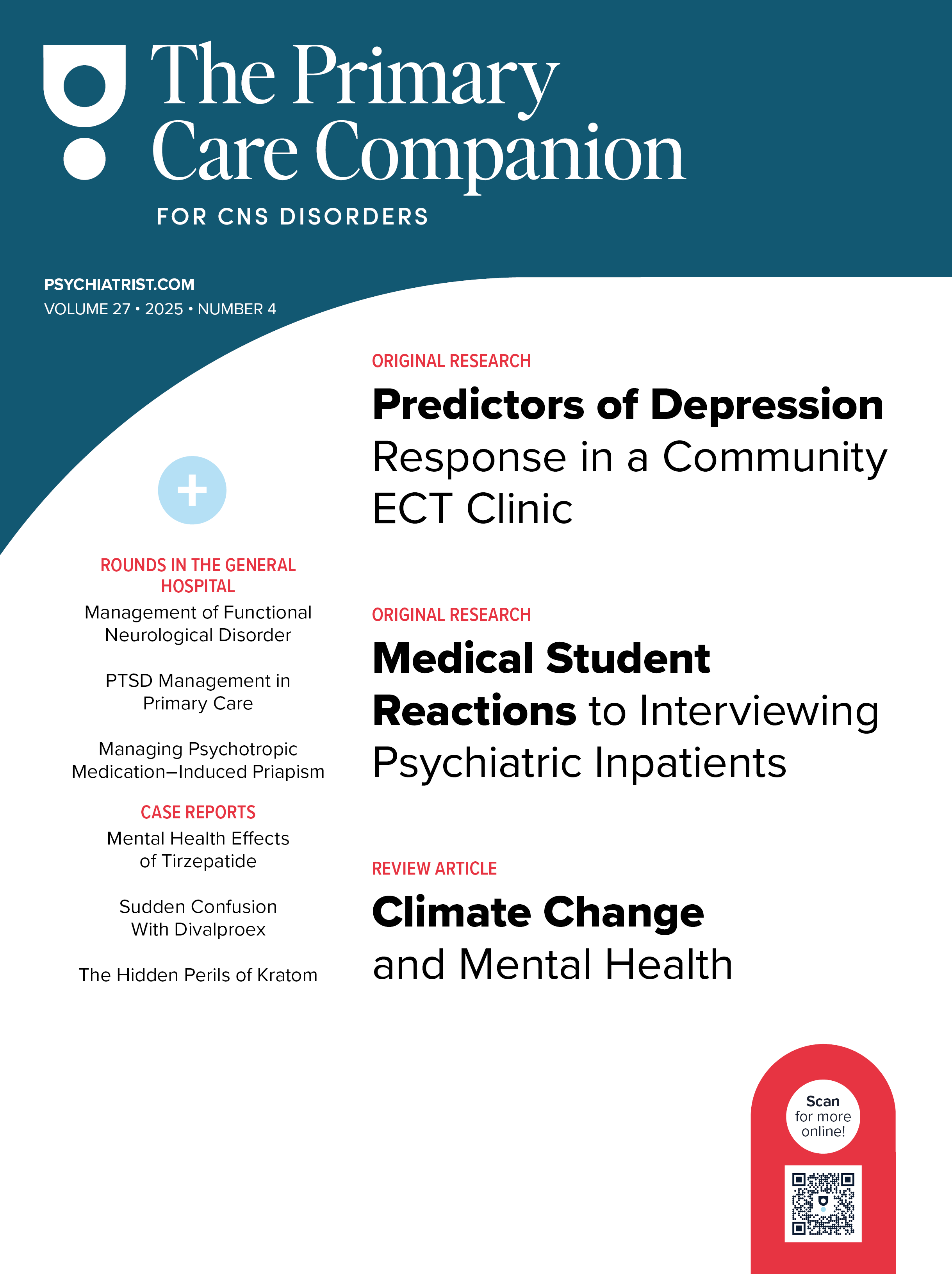Because this piece does not have an abstract, we have provided for your benefit the first 3 sentences of the full text.
Quetiapine is a commonly prescribed second-generation antipsychotic with a wide range of uses in psychiatry. Compared to first-generation high-potency antipsychotics such as thioridazine and high-dose intravenous haloperidol, medications in the newer second-generation antipsychotic class (of which quetiapine belongs) are thought to have a lower risk of prolonging the corrected QT (QTc) interval, torsades de pointes, and sudden death. Among the second-generation antipsychotics of its class, quetiapine is known to prolong the QTc interval in modest levels and less so than ziprasidone and sertindole.
Probable Acquired QTc Prolongation and Subsequent Torsades de Pointes Attributable to Quetiapine
To the Editor: Quetiapine is a commonly prescribed second-generation antipsychotic with a wide range of uses in psychiatry. Compared to first-generation high-potency antipsychotics such as thioridazine and high-dose intravenous haloperidol, medications in the newer second-generation antipsychotic class (of which quetiapine belongs) are thought to have a lower risk of prolonging the corrected QT (QTc) interval, torsades de pointes, and sudden death.1,2 Among the second-generation antipsychotics of its class, quetiapine is known to prolong the QTc interval in modest levels and less so than ziprasidone and sertindole.1-3
Although considered uncommon, rare case reports and US Food and Drug Administration (FDA) adverse event reports of torsades de pointes with quetiapine prompted the FDA to direct AstraZeneca to add a warning of increased risk of torsades de pointes in patients with cardiac risk to the drug label in 2011.4 To our knowledge, only 12 published cases of QTc interval prolongation, including only 4 cases of torsades de pointes associated with quetiapine, have been reported in the medical literature.4 These rare events have all been associated with either quetiapine overdose or other known risk factors for acquired long QT. Some of the most well-known risk factors include female sex, hypokalemia, hypomagnesemia, cardiac disease, thyroid disease, and concurrent use of other QT-prolonging medications or cytochrome P450 inhibitors. Here, we present the case of a woman with a prolonged QTc who subsequently developed torsades de pointes, ventricular fibrillation, and cardiac arrest in the setting of quetiapine use for bipolar disorder.
Case report. Ms A is a Chinese-American woman in her 30s with a past psychiatric history of bipolar II disorder and unspecified anxiety disorder and a medical history significant for obesity, hypothyroidism, and congenital rubella syndrome with remote patent ductus arteriosis closure. Ms A had been maintained on multiple psychotropic medications, including lamotrigine, quetiapine, venlafaxine, and as-needed clonazepam. She had been taking quetiapine for at least 1 year and per records had been titrating the dose for the past 2 months. Other significant medications included levothyroxine.
Ms A presented to the emergency department after ventricular fibrillation and cardiac arrest following a witnessed syncopal episode at home. She had reportedly not been feeling well and according to her caregiver was unable to take all of her regularly scheduled medications on at least the day of the cardiac event and possibly the day prior. Her caregiver was unable to provide details with regard to which medicines and how many total doses were missed. Cardiopulmonary resuscitation was initiated within 2 minutes of the initial cardiac event and continued for 7 minutes. Emergency medical services arrived and found Ms A to be in ventricular fibrillation, and she was shocked ×— 1 to return of spontaneous circulation. The automatic external defibrillator rhythm strip showed polymorphic ventricular tachycardia consistent with torsades de pointes and subsequent degeneration into ventricular fibrillation. She was intubated and at arrival to the emergency department was comatose with reactive pupils but no withdrawal or response to pain. Her lungs were clear to auscultation, with detectable end-tidal CO2, a distended abdomen, and otherwise unremarkable examination. Thyroid-stimulating hormone and electrolyte levels were within normal ranges, including potassium and magnesium levels.
Initial EKG showed sinus tachycardia at 124 bpm, nonspecific ST segment, and T wave changes in the lateral leads. Bazett-corrected QTc was 485 msec. No previous EKG was on file for comparison. Subsequent EKGs during the hospital course showed QTc intervals, corrected with Bazett’s formula when appropriate, in the low to mid 490s (msec). She underwent a transthoracic echocardiogram, which showed moderate global left ventricular systolic dysfunction (ejection fraction: 35%-40%), normal right ventricular size and systolic function, and no significant valvular abnormalities. A left heart catheterization was also performed and showed no significant coronary artery disease.
The patient was extubated on day 2 after being assessed as near her baseline level. Following a negative cardiac catheterization, it was concluded that the etiology of ventricular fibrillation and cardiac arrest was most likely torsades de pointes from acquired QTc prolongation secondary to quetiapine. Her quetiapine dose was gradually tapered during the hospitalization, and periodic EKGs demonstrated a down-trending QTc interval (467 msec at discharge). Ms A was recommended for Lifevest (ZOLL Medical Corporation, Pittsburgh, Pennsylvania) and outpatient consideration for an implantable cardioverter defibrillator if she was determined to require QT-prolonging medications chronically.
We report on a rare but significant example of acquired prolonged QTc and torsades de pointes in a patient taking quetiapine. This patient did have significant proarrhythmogenic risk factors including female sex, cardiac and thyroid disease, and polypharmacy; however, her daily quetiapine dosage was relatively average at 400 mg/d. It bears mentioning that the coadministration of both venlafaxine and quetiapine in this patient may have put her at increased risk for QT prolongation. One case report5 described QT-prolonging effects due to venlafaxine monotherapy in a patient being treated for depression. Also, both venlafaxine and quetiapine are cytochrome P450 enzyme substrates, and, thus, competitive inhibition by either substrate could have increased the other’s plasma levels. A similar competitive effect was discussed in a case report6 of a patient taking quetiapine and lovastatin. Additionally, our patient’s Bazett-corrected QTc interval peaked at 495 msec, which while certainly prolonged, may not be considered an extreme elevation. In fact, a recent case series7 of 28 patients with episodes of torsades de pointes due to acquired long QT showed a mean QTc interval of 638 msec with a range of 502 to 858 msec. We acknowledge that our patient’s peak QTc of 495 msec is significantly less than the mean of 638 msec in the previous study7 and below the general threshold of > 500 msec that many physicians use in practice. While our case may be somewhat unusual in this regard, we believe that in a patient such as ours, with the history and risk factors given, that any significant elevation above normal QTc level is cause for concern.
This case should serve as a reminder that although quetiapine is considered to have an overall lower risk for QT prolongation among other first- and second-generation antipsychotics, it can cause significant morbidity and mortality in patients with known risk factors. Physicians must weigh the benefits and risks of psychotropic medications such as quetiapine on an individual basis, taking into account the patient’s underlying comorbidities and risk factors for an arrhythmogenic event. This case demonstrates the importance of monitoring both baseline and interval EKGs in patients taking psychotropic medications.
References
1. Beach SR, Celano CM, Noseworthy PA, et al. QTc prolongation, torsades de pointes, and psychotropic medications. Psychosomatics. 2013;54(1):1-13. PubMed CrossRef
2. Wenzel-Seifert K, Wittmann M, Haen E. QTc prolongation by psychotropic drugs and the risk of torsade de pointes. Dtsch Arztebl Int. 2011;108(41):687-693. PubMed CrossRef
3. Glassman AH, Bigger JT. Antipsychotic drugs: prolonged QTc interval, torsade de pointes, and sudden death. Am J Psychiatry. 2001;158(11):1774-1782. PubMed CrossRef
4. Hasnain M, Vieweg WVR, Howland RH, et al. Quetiapine, QTc interval prolongation, and torsade de pointes: a review of case reports. Ther Adv Psychopharmacol. 2013;4(3):130-138. PubMed CrossRef
5. Letsas K, Korantzopoulos P, Pappas L, et al. QT interval prolongation associated with venlafaxine administration. Int J Cardiol. 2006;109(1):116-117. PubMed CrossRef
6. Furst B, Champion K, Pierre J, et al. Possible association of QTc interval prolongation with co-administration of quetiapine and lovastatin. Biol Psychiatry. 2002;51(3):264-265. PubMed CrossRef
7. Kukla P, Jastrzębski M, Fijorek K, et al. Electrocardiographic parameters indicating worse evolution in patients with acquired long QT syndrome and torsades de pointes. Ann Noninvasive Electrocardiol. 2016;21(6):572-579. PubMed CrossRef
aJohn A. Burns School of Medicine, Honolulu, Hawaii
bDepartment of Psychiatry, John A. Burns School of Medicine, Honolulu, Hawaii
Potential conflicts of interest: None.
Funding/support: None.
Additional information: The case was de-identified to protect anonymity.
Published online: November 23, 2017.
Prim Care Companion CNS Disord 2017;19(6):17l02106
https://doi.org/10.4088/PCC.17l02106
© Copyright 2017 Physicians Postgraduate Press, Inc.
Please sign in or purchase this PDF for $40.00.




